Last Chance to Catch NYC's Holiday Notalgia Train
We met the voices of the NYC subway on our nostalgia ride this weekend!



After over a year away, theatre is back where it belongs: in New York City. Broadway has reopened and in celebration, we’ve partnered with TodayTix to showcase all the shows you can catch in Times Square’s historic theaters. Whether you’re looking forward to doing date night at Moulin Rouge! The Musical, an afternoon out with the kids at The Lion King, or gathering your closest friends to bond over Sara Bareilles in Waitress, download the TodayTix app or go to their website for access to Broadway tickets from $29. With access to discounted prices on both same-day tickets and advance performances, a mobile Lottery program, and check out in seconds via multiple convenient payment methods, no matter what show you want to see, or when you want to see it: TodayTix has a seat for you. Use code “Untapped” to save $10 off your first purchase.
Times Square not only hosts secrets under its surface, it is home to the city’s theater district where plays, musicals, actors, writers, and everyone in the industry go to make their mark. The area is home to beautiful historic theaters, some still standing as operating theaters, others converted and repurposed, while some have closed entirely. Still, there are many theaters still standing with many open with new shows or reopening soon!
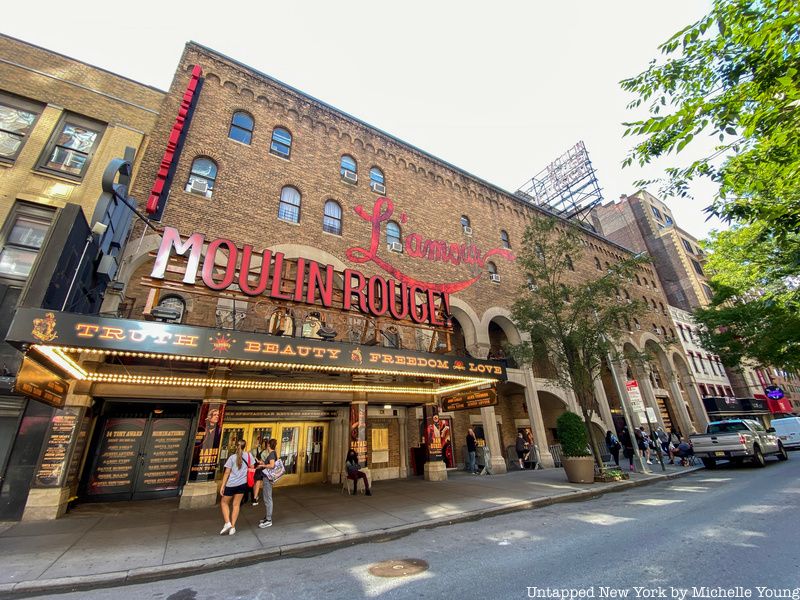
Also owned and operated by Jordan Roth of Jujamcyn Theatres, Al Hirschfield Theatre opened on November 11, 1924 with a seating capacity of 1,424. It was designed by architect G. Albert Lansburgh, who was largely known for his work on luxury theaters and cinemas. The Byzantine and Moorish-style building at 302 West 45th Street was built for vaudeville promoter Martin Beck. It was also the only theater to be owned without a mortgage at the time, and its opulence was reflected in its massive dressing rooms that could fit 200 actors.
After Beck’s death in 1940, his wife Louise Heims Beck, who was instrumental in creating the Tony Awards, took over operations. It was purchased in 1965 by Jujamcyn Theatres and was renamed in 2003 to honor Al Hirschfield, a caricaturist known for his drawings of Broadway celebrities. Hirschfield passed away just a few months before his 100th birthday, and figures like Arthur Miller and Matthew Broderick made appearances at the renaming ceremony. The theater has also drawn in some big names, such as Daniel Radcliffe in How to Succeed in Business Without Really Trying, Elizabeth Taylor in The Little Foxes, and Christina Applegate in Sweet Charity. It will reopen on September 24th, 2021 with the return of Moulin Rouge! The Musical.

The Ethel Barrymore Theatre was opened on December 20, 1928 at 243 West 47th Street. Constructed by the Shuberts and designed by Krapp, the theater opened with The Kingdom of God, a play selected by its namesake actress. Barrymore was often regarded as “The First Lady of the American Theatre” for her six-decade career, as well as her support for the Actors’ Equity Association and her close relationship with figures such as Winston Churchill.
The theater is the last of the Shubert theaters remaining that was built for performers affiliated with them. Barrymore starred in a number of productions in the next dozen years, including The School for Scandal. Other notable shows at the theater have included The Band’s Visit, which grossed $1,564,646 over nine performances in just one week in December 2017. The hit musical Waitress , currently playing, grossed $197,878 in ticket sales on Friday, September 3, 2021, which broke the theater’s all-time record. The theater, which in the past has put on productions of plays including A Raisin in the Sun and Betrayal, will also put on Paradise Square in 2022. Get tickets to Waitress!
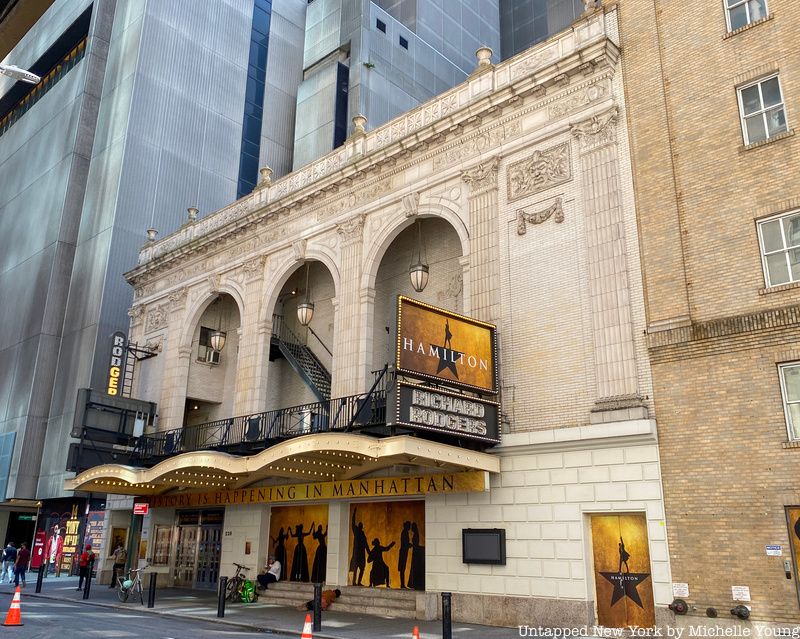
Richard Rodgers Theatre, located at 226 West 46th Street, is a 1,319-seat theater that has housed 11 Tony Award-winning Best Plays and Best Musicals, more than any other Broadway theater. The theater was built by Irwin Chanin, an Art Deco architect who designed theaters such as The Majestic with his construction company. It opened in December 1925, and it was renamed the 46th Street Theatre in 1931. After a number of shifts in ownership, including at one point by real estate investor Robert W. Dowling, the Nederlander Organization purchased the structure and renamed it Richard Rodgers Theatre in honor of the legendary composer of 43 musicals.
The theater was notably the first to use the Chanin seating plan, in which all guests entered through one entrance and took a series of steps inside to get to their seat, as opposed to separate entrances for higher and lower levels. Notable productions at the theater have included Guys and Dolls, Damn Yankees, 1776, Lost in Yonkers, and In the Heights. It has also been the theater for Hamilton since 2015, which won the 2016 Tony Award for Best Musical and 2016 Pulitzer Prize for Drama. Hamilton reopened on September 14 to a full house.
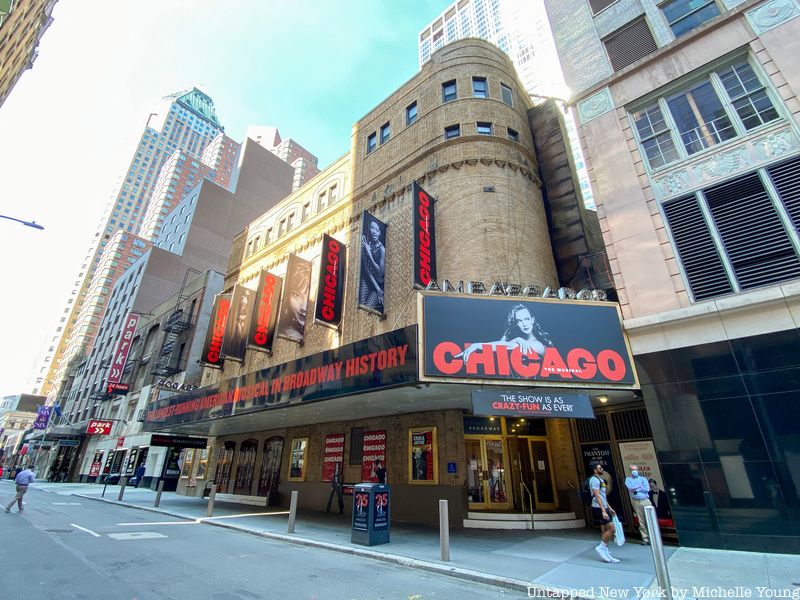
The Krapp-designed Ambassador Theatre at 219 West 49th Street is a smaller venue that fits 1,114. The interior is actually situated diagonally on its site to fit the maximum number of seats possible, which is not visible from the rather standard exterior. The theater opened on February 11, 1921 with a performance of the musical The Rose Girl.
The property was sold in 1935, and for two decades it served as both a movie theater and a television studio for NBC and the DuMont Television Network. It was repurchased by the Shuberts, who then converted it back into a theater, kicking off with a stage adaptation of The Diary of Anne Frank. Notable productions in the landmarked space included Godspell in 1977, Dreamgirls revival in 1987, and Bring in ‘da Noise, Bring in ‘da Funk in 1996. Since 2003, the theater has housed Chicago, which reopened on September 14.
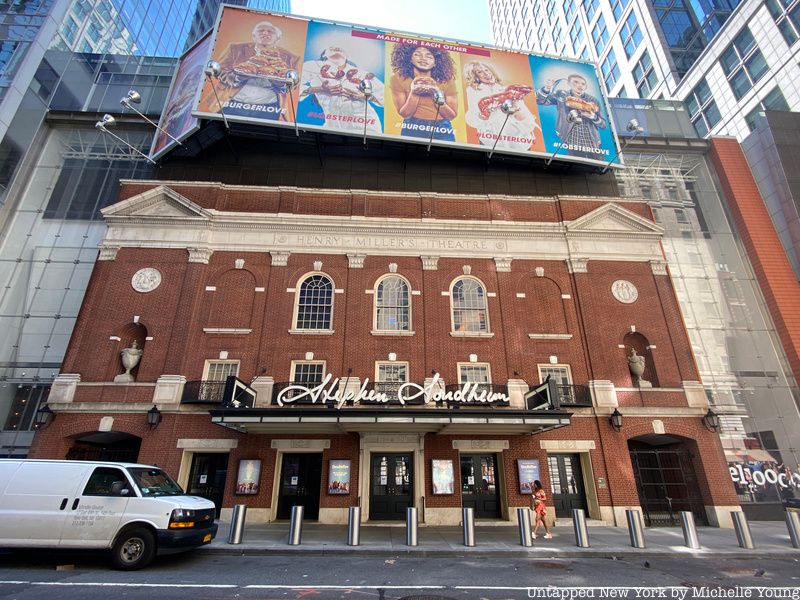
The Stephen Sondheim Theatre at 124 West 43rd Street dates back to 1918, becoming Manhattan’s first air-conditioned theater. The Neoclassical-style building was originally named for actor-producer Henry Miller (whose name is still etched on the frieze of the facade), and it housed 950 people. After wide success from Noël Coward’s The Vortex in 1926, the theater achieved its Golden Years through the 1960s, featuring regulars like Helen Hayes, Leslie Howard, and Douglas Fairbanks.
However, after being sold to Seymour Durst, the venue became a movie theater, then a porn theater, then a disco, then a number of nightclubs. In 1998, the facility briefly became the Kit Kat Club that housed Roundabout Theatre Company’s popular revival of the musical Cabaret. The theater ultimately closed in 2004, and its interior was demolished. The new theater opened in September 2009 with a production of the musical Bye Bye Birdie. A year later, the theater was renamed in honor of the legendary Stephen Sondheim, and since 2010 the theater has housed six shows including Beautiful: The Carole King Musical. It will reopen on October 21, 2021 with performances of Mrs. Doubtfire.
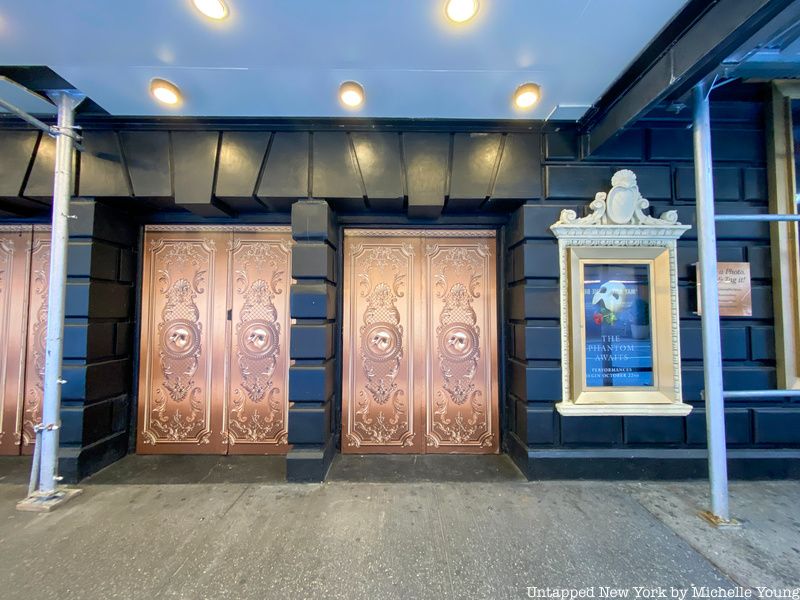
The Majestic Theatre is one of the largest on Broadway, seating 1,681 guests and hosting many of Broadway’s most successful shows. Opened on March 28, 1927, the Spanish-style theater was constructed as part of a complex alongside the Theatre Masque, the Royale Theatre, and the Lincoln Hotel. Currently owned and operated by the Shubert Organization, the theater hosted the benefit concert Broadway Answers Selma, to raise money for the civil rights movement.
The theater is perhaps most notable for housing The Phantom of the Opera since it opened on January 26, 1988. It is currently the longest-running production in Broadway history, with over 13,300 performances to date. The venue has also premiered shows such as Carousel, South Pacific, The Music Man, A Little Night Music, and The Wiz. The musical 42nd Street also had a seven-year run at the theater. The Phantom of the Opera will return on October 22, 2021 with tickets starting at $29.

The original Lyric Theatre was built in 1903 by developer Eugene C. Porter, intended as the home of composer Reginald De Koven’s American School of Opera. Since the school went bankrupt before construction was even finished, Potter leased the theater to the Shubert brothers. During the 1920s, many Shakespeare plays were produced, such as The Merchant of Venice, Hamlet, and Othello. In 1925, the Marx Brothers had one of their earliest Broadway shows here called The Coconauts, a show that eventually became their first feature film. Finally, Cole Porter’s Fifty Million Frenchmen opened here in 1929.
In 1934, the theater suffered from some major production flops and was forced to become a movie theater. In 1996, the Lyric, along with the Apollo Theatre were demolished. The facade of the Lyric and proscenium arch, lobby and ceiling of the Apollo were incorporated into the new theater. It would go through a few names until March 2014, when it was renamed the Lyric Theater. After the new theater was constructed in 1997, it became the second largest theater in Times Square behind the Gershwin. It ran the notable (and controversial) musical Spider-Man: Turn Off The Dark (2011), and ran the Broadway debut of Ragtime in 1998. It will reopen on November 12, 2021 with performances of Harry Potter and the Cursed Child, which has been located in the Lyric Theatre since its opening in 2018.

Named for George and Ira Gershwin, the Gershwin Theatre is the largest capacity Broadway theater with 1,933 seats, located at 222 West 51st Street. Set designer Ralph Alswang created the Art Nouveau structure, which opened on November 28, 1972. The theater was built on the site of the former Capitol Theatre, which had a seating capacity of 5,230 and was known as the premiere site of many Metro-Goldwyn-Mayer (MGM) films. The lobby of the building contains The American Theatre Hall of Fame, and the theater’s 80-foot-wide stage allows for larger productions.
The venue was originally called the Uris Theatre, named for building developer Uris Buildings Corporation. From 1974 to 1976, it served as a concert hall for musicians such as Frank Sinatra and Ella Fitzgerald, and it shifted to hosting large musicals with a production of Porgy and Bess, composed by the Gershwins. The theater has also hosted the Tony Awards six times between 1983 and 1999. Notable productions have included 1987’s Starlight Express by Andrew Lloyd Webber, for which the theater had to be heavily modified, The King & I, Show Boat, Candide, and Oklahoma! Since 2003, the theater has housed Wicked, which reopened on September 14.
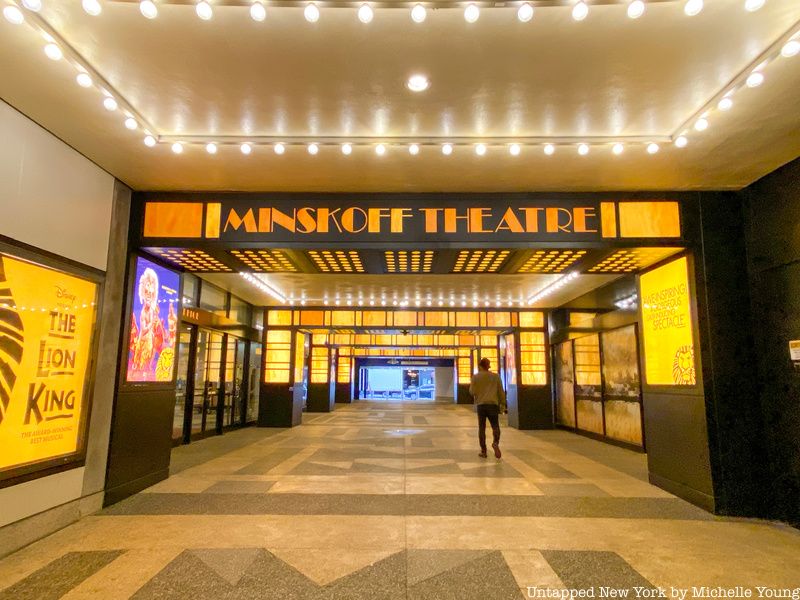
Almost as large as the Majestic Theatre, the Minskoff Theatre is a 1,621-seat venue at 1515 Broadway on the third floor of One Astor Plaza. The theater is named after Sam Minskoff and Sons, who built and owned the building. Minskoff Theatre is one of the newer Broadway theaters, opening its doors on March 13, 1973, with a revival of Irene starring Debbie Reynolds. The theater has hosted a number of non-theatrical works as well, including Miss University 1981.
Since 2006, the theater has put on productions of The Lion King, which pulled in $3,696,977 over 12 performances for the week ending January 2, 2019. Other productions at the theater have included Joseph Papp’s production of The Pirates of Penzance, West Side Story, Cabaret, and Sunset Boulevard. The theater reopened on September 14 with a much-awaited performance of The Lion King.

Located at 230 West 49th Street, the 1,108-seat Eugene O’Neill Theatre opened on November 24, 1925. It was designed by Herbert J. Krapp, who designed fifteen current Broadway theaters. Krapp built it for The Shubert Organization as part of a complex named for Edwin Forrest, an American Shakespeare actor who faced off against William Macready in the Astor Place Riot. Opening with the musical Mayflower, the theater was renamed the Coronet Theatre in 1945.
In 1959, then-owner Lester Osterman renamed it in honor of Eugene O’Neill, the Nobel laureate behind greats such as Long Day’s Journey Into Night and The Iceman Cometh. Neil Simon later purchased the historic venue and sold it to Jujamcyn Theatres. Big hits have included Spring Awakening, M. Butterfly, Death of a Salesman, and the long-running 2011 Tony Award Best Musical winner, The Book of Mormon, which will reopen on November 5, 2021.
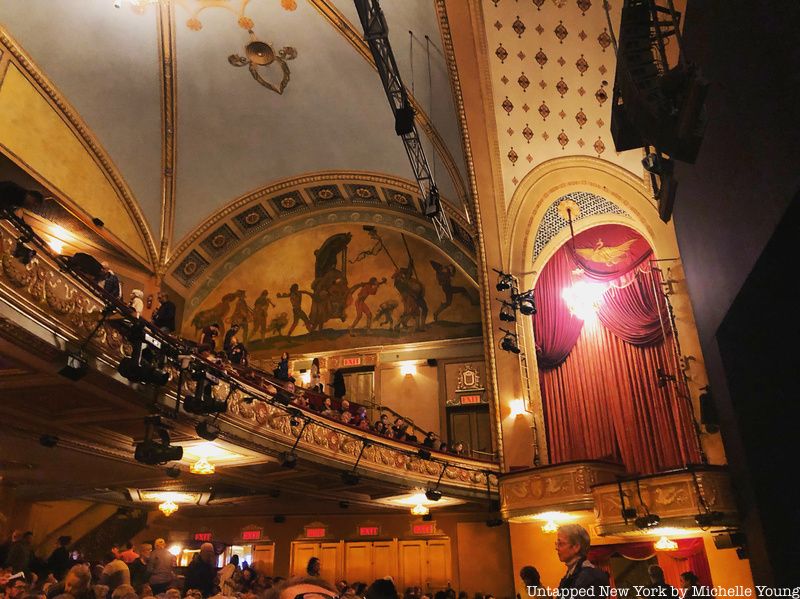
Built alongside the Majestic Theatre, the Bernard B. Jacobs Theatre is a 1,100-seat venue located at 242 West 45th Street. Another of Krapp’s architectural feats, the theater opened on January 11, 1927 with a musical entitled Piggy. Boasting an ornate stone facade with large vaulted windows, as well as murals by Hungarian illustrator Willy Pogany, the theater began as the Royal Theatre but quickly changed its name to the John Golden Theater, after the namesake producer, for five years. The theater’s current namesake was a longtime Shubert Organization president.
The historic theater put on a production of Tennessee Williams’s The Glass Menagerie two years after it was published, drawing in major crowds. Also popular were productions of Joseph and the Amazing Technicolor Dreamcoat, Copenhagen, Glengarry Glen Ross, and Once (which broke the box office record). The theater will reopen on November 15, 2021 with performances of Company.
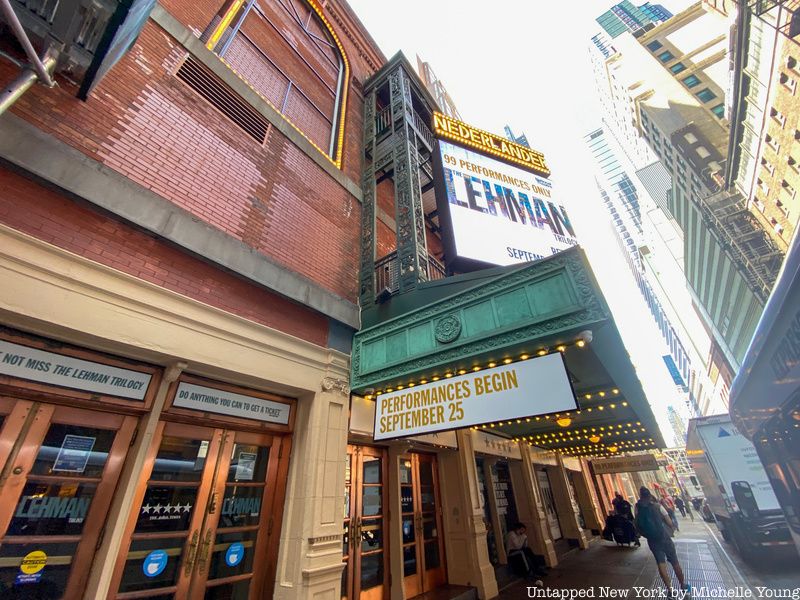
The David T. Nederlander Theatre opened on September 1st, 1920 as the National Theatre with 1,232 seats. Built by Walter C. Jordan at the cost of $950,000, it is the southernmost Broadway theater and was owned by the famous Shubert Organization until 1956. The Nederlander Organization, the owner of a total of nine Broadway theaters, purchased the venue from Billy Rose, a famous showman and lyricist, in 1979. They briefly named it the Trafalgar Theatre before changing it to the David T. Nederlander in 1980.
Some notable productions include Lena Horne’s 1981 one-woman show Lena Horne: The Lady and Her Music, which won her a special Tony Award, along with two original Broadway productions: 1962 Edward Albee’s Tony Award-winning production of Who’s Afraid of Virgina Woolf? and Jonathan Larson’s 1996 acclaimed Rent. Famous illusionist and stunt performer Harry Houdini appeared on stage at the National Theatre in the 1920s. It will reopen on September 25 with performances of The Lehman Trilogy.
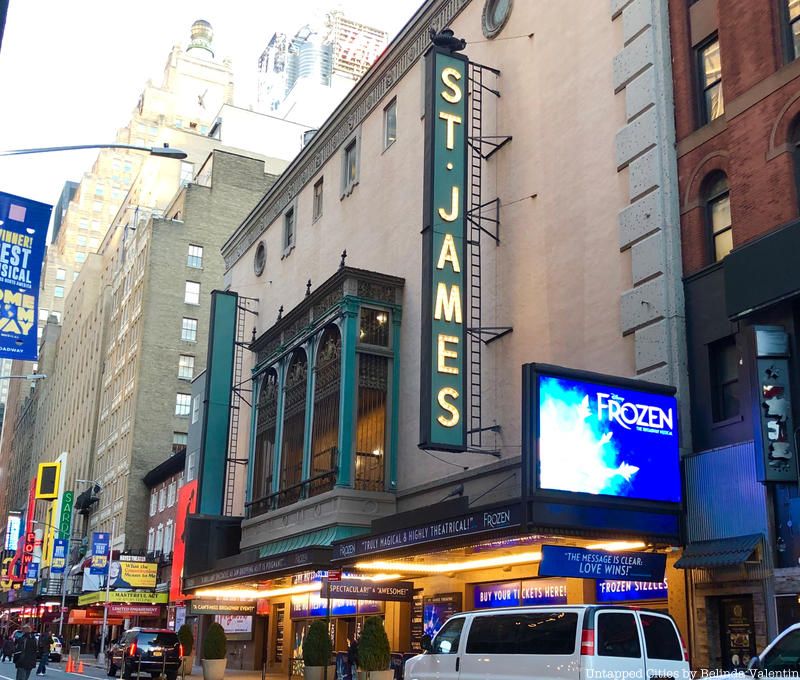
Opened in 1927, the St. James opened originally as Erlanger’s Theatre, built by and named after Abraham Erlanger, the founder of the Theatrical Syndicate. In 1932, it was renamed the St. James after the theater in London of the same name. Following the Great Depression, the theater was bought by none other than the Shubert’s in 1941. However, fearing monopoly accusations, they turned it over management to the Jujamcyn Amusement Corporation. Jujamcyn renovated the theater and reopened it in December of 1958.
The theater has been the location of a number of famous productions and one of the biggest box office records on Broadway. In 2001, The Producers set box-office records for single-day sales, introduced “premium seating,” and garnered an impressive 12 Tony Awards. In April and May of 2013, notable director Alejandro González Iñárritu filmed the Academy Award winner Birdman in and around the St. James Theatre for 30 days. Other notable premieres held here were Oklahoma! (1943), The King and I (1951), and Hello, Dolly! (1964).On June 7, 2021, Bruce Springsteen announced that he would give a limited run of 31 performances of his Springsteen on Broadway shows at the theater. David Byrne’s American Utopia will open on September 17.
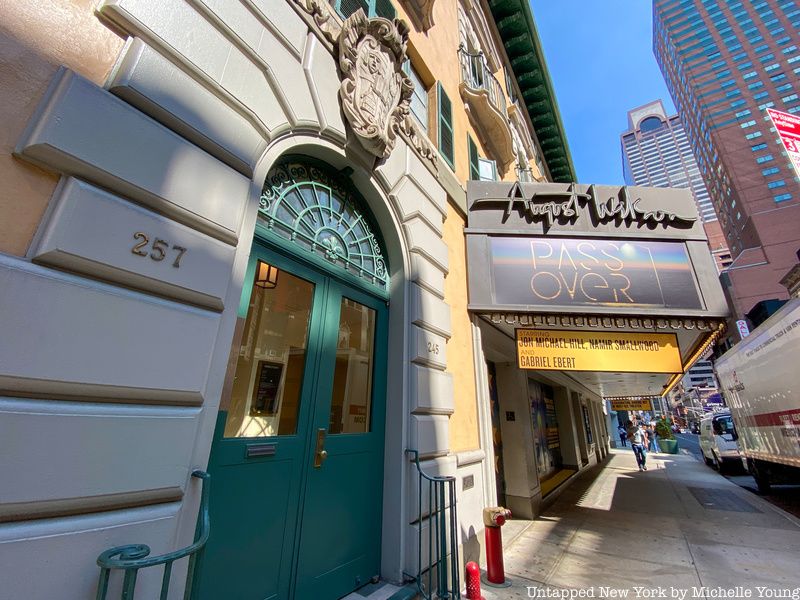
Opened in 1925, the August Wilson Theatre honors Pulitzer Prize-winning playwright August Wilson, who wrote a series of ten plays called The Pittsburgh Cycle. Designed by architects C. Howard Crane and Kenneth Franzheim, it opened as the Guild Theatre and first performed a revival of George Bernard Shaw’s play Caesar and Cleopatra. The theater was purchased in 1950 by The American National Theater and Academy, and three decades later it was bought by Jujamcyn Theaters, which still operates the theater to date under producer Jordan Roth.
The 1,222-seat theater has staged productions of Our Town in 1969, Cat On a Hot Tin Roof in 1974, Little Shop of Horrors in 2003, and its longest-running show Jersey Boys from 2005 to 2017. The theater changed its name to honor the late Wilson in 2005 just two weeks after his death. The theater put on Mean Girls from 2018 until Broadway was shut down. It reopened on August 4, 2021 with Pass Over, the play that made history by being the first stage play to re-open on Broadway.

Helen Hayes Theatre, also known as “The Little Theatre,” was built by producer Winthrop Ames in 1912 in rebellion against commercial theaters at the time and held only 299 seats. In the 1950s, it was used as a recording studio for TV and radio. In 1983, it was renamed for American actress Helen Hayes after another theater by the same name was demolished. The former theater was one of five that met the wrecking ball, replaced by the Marriott Marquis hotel.
In April 2015, the theater was bought by Second Stage Theatre, which made it only one of four not-for-profit theaters on Broadway. However, the purchase was hard earned since the company had to fight for ownership but ultimately prevailed. Today, the Helen Hayes Theatre has 597 seats, retaining its title for the smallest on Broadway. It recently housed productions of The Humans and What the Constitution Means to Me. It will reopen on November 3, 2021 with performances of Clyde’s, starring Uzo Uduba and Ron Cephas Jones.\
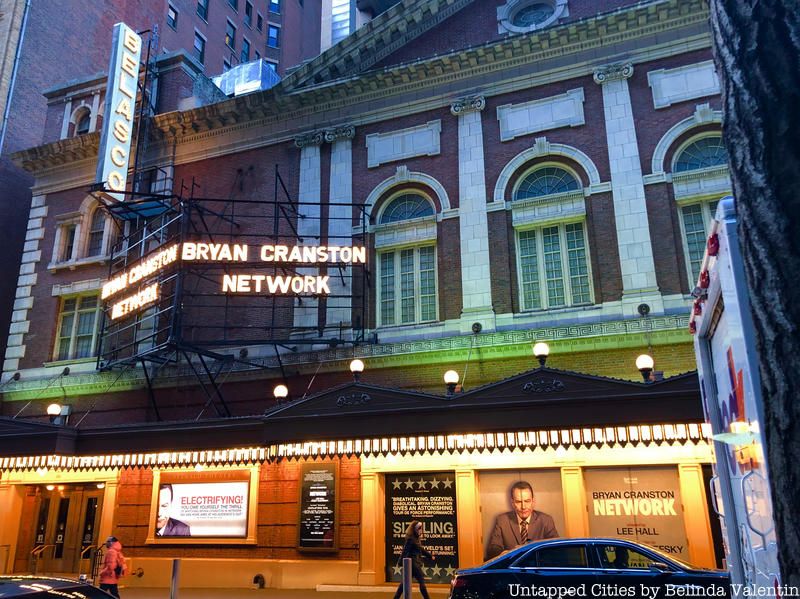
The Belasco Theatre opened in 1907 as the Stuyvesant Theater for impresario David Belasco, and the theater was named after him in 1910. Designed by architect George Keister, the structure’s interior featured Tiffany lighting and ceiling panels, along with murals by artist Everett Shinn. Belsaco had an apartment above the theater,
In 1948, the Belasco changed hands and came under Shubert ownership.Interestingly enough, this venue was also the first widely noticed successful performance of Marlon Brando, where he played a small but crucial role in a Maxwell Anderson production of Truckline Cafe. In 1987, the Belasco was named a New York City Landmark, along with its interior. The 2014 production of Hedwig and the Angry Inch was the theater’s longest running show. It will reopen on October 13, 2021 with performances from Girl From The North Country.
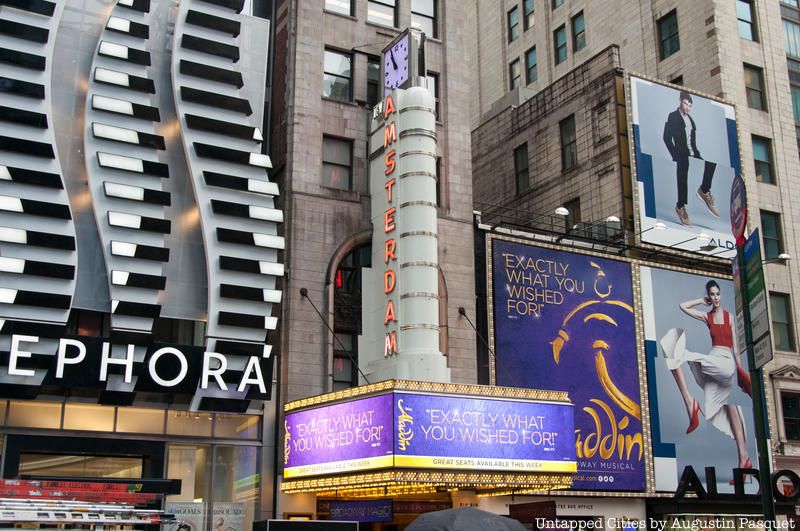
Built in 1903 by producers A.L. Erlanger and Marcus Klaw and designed by architects Hertz & Tallent, the New Amsterdam Theatre was the largest on Broadway at the time with 1,702 seats. It is also one of the oldest theaters in the area. It originally had a roof garden, where more risqué shows were shown. From 1913 to 1927, the New Amsterdam had a lot of success as the home to the Ziegfeld Follies, which was somewhere between a later Broadway show and high class vaudeville act. But when the Depression hit, the theater did not fare so well, and it could not fully recover until the 1990s.
Although it remained in disrepair after becoming a movie theater during the Depression, its beautiful Beaux-Arts facade and interior earned the theater a landmark designation on October 23, 1979. Much like many Broadway theaters, the New Amsterdam was bought by the Shubert Organization in 1982. The State and City of New York was able to win the theater back in a court ruling and under a new, 99-year lease signed by Disney, the New Amsterdam reopened in 1997 as a Broadway theater once more. Since then it has run many popular Disney musicals such as The Lion King, Mary Poppins and Aladdin. It will reopen September 28, 2021 with performances of Aladdin.

Another of the oldest theaters on Broadway, the Hudson Theatre was built in 1902-1904, helping shape Times Square as New York City’s new theater district. The theater boasts a 100-foot long lobby (the largest at the time) and a backlit stained glass ceiling manufactured by Tiffany. It also had impressive safety features at the time with 28 exits, completely fireproofed and fashioned with a complete sprinkler system. The Hudson was built by Henry B. Harris, who was at the time one of the era’s top Broadway producers. His success in New York led him to build another theater, the Folies Bergere (which became the original Helen Hayes). Harris unfortunately died in the sinking of the RMS Titanic. On November 17, 1987, the Hudson received landmark status.
From the 1930s to the 1950s, the Hudson was a television studio owned by CBS Studios. NBC purchased it in 1950, and in 1954 it was the home of The Tonight Show with Steve Allen. In 1956, developer Adam Hirschfeld turned it back into a theater, and then into a movie house. In 1980, it became the Savoy Rock Club, and in 1995 it was bought up by Millenium & Copthornes Hotels where the theater served as a conference and party space. Recently, the Ambassador Theatre Group under the subsidiary Hudson Theatre LLC entered a long-term lease of the Hudson Theatre. It will reopen on February 22, 2022 with performances of Plaza Suite, starring Sarah Jessica Parker and Matthew Broderick.

Built by the Selwyn Brothers, American Airlines Theatre opened on October 2, 1918, operating as a fairly successful theater until 1934. The Selwyn Brothers, who would found the American Play Company, were famous in the business, and after opening the Selwyn, they opened two more theaters in New York (the Times Square and the Apollo), and two more in Chicago (Selwyn and Harris). In 1934, the theater began to suffer in the decline of popular performances and was forced to become a movie theater. In 1950, it became a hybrid movie and short performance house where it was able to put on a few shows, including Sartre’s The Respectful Prostitute. In 1960, it became a double-feature movie house and continued to be a movie theater throughout the ’80s and ’90s.
The theater was also part of the 42nd Street redevelopment plan headed by the city. In 1987, when the Roundabout Theatre Company was looking to lease one of Broadway’s decaying theaters, it originally wanted the Liberty but got the Selwyn instead. After years of renovations, Roundabout reopened the Selwyn in 2000 as the American Airlines Theatre (they were lead supporters of the renovation project). Today it continues to operate as a legitimate Broadway theater once more but was also removed off of landmarks consideration. It will reopen with performances of Trouble In Mind on October 29th.

In 1900, the grandfather of famous lyricist Oscar Hammerstein built the New Victory Theater as the Theatre Republic. The architecture features a Venetian style facade with a grand staircase in the front. On the roof of the theater was the Paradise Roof Gardens where a miniature Dutch village was created for theater goers to enjoy, complete with cows, ducks, chickens, and even a milkmaid to give children fresh milk. In 1902, David Belasco took over the theater and renamed it after himself, only to change it back in 1910 to the Republic Theatre when he took control of the other Belasco Theatre. Under Belasco, the theater underwent some major technological changes so that more elaborate shows could be performed. With an orchestra pit, a modern stage, and new lighting system, the venue was able to attract some great talent. In 1923, Abie’s Irish Rose was performed, giving Belasco a hit and Broadway its third-longest-running play in history at 2,327 performances.
From the 1930s to 1942, the New Victory was turned into Broadway’s first burlesque club and renamed Minsky’s Republic. Minsky redid much of the architecture and added many features which would remove some of the original Venetian style. When Mayor LaGuardia banned burlesque in 1942, the Minsky became a movie theater. The eruption of World War II ushered in a period of patriotism, renaming the Minsky Republic to the New Victory. The theater suffered much like many Broadway theater, and in 1972, it became the block’s only XXX-rated movie theater. The City and State of New York breathed new life into the theater (and many others) by establishing the New 42nd Street, a nonprofit to revamp many of the theaters put into disrepair. The New Victory opened on December 11, 1995 New York’s only full-time performing arts center for kids and families. The theater will not be considered for landmark status.

Built in 1903 producer-manager David Frohman, the Lyceum is Broadway’s oldest continually operating theater. When the theater opened, it had a state of the art ventilation system that kept it cool in the summers and warm in the winters. Forhman also built an apartment above the theater which had a small door with a view of the stage. Rumor has it that when his wife, actress Margaret Illington, was acting, he would wave a white handkerchief outside the door to tell her she was overacting. He partnered with his brother Charles on many productions, though their partnership ended when Charles died on the RMS Lusitania in 1915.
When it was built, it replaced the original Lyceum on 4th Avenue, which closed in 1902. Designed by architects Herts & Tallant in the Beaux-Arts style, today much of the original architecture survives. In 1940, the Lyceum was purchased by a consortium of producers but changed hands once again in 1950 when the Shubert’s took ownership. Along with being one of the oldest theaters still operating, the Lyceum was also the first theater to be granted landmark status in 1974. At three levels, it’s also one of the smallest theaters on Broadway in terms of capacity, able to seat only 950. Notable productions that ran here were the Broadway debut of The Good Country Girl (1950), Hatful of Rain (1955), Whoopi Golderberg (1984) her one-woman show.

The Embassy Theater opened on August 26, 1925 as an experiment by Loew’s Inc., which was a 556-seat movie theater meant for an exclusive high-class audience. As in the style of the previous theaters listed before this, it was known for its beautiful architecture, designed by Thomas Lamb.
In 1929, the theater reopened after being acquired by Guild Enterprises, and it became the first theater in the United States to have an all-newsreel format. By the 1950s, patronage began to decrease and the theater had to go back to a first-run movie theater showing feature films. In 1987, the Embassy was designated a New York City Landmark. Despite its notoriety, the theater closed in 1997, only to reopen in 1998 as the Times Square Visitor’s Center.
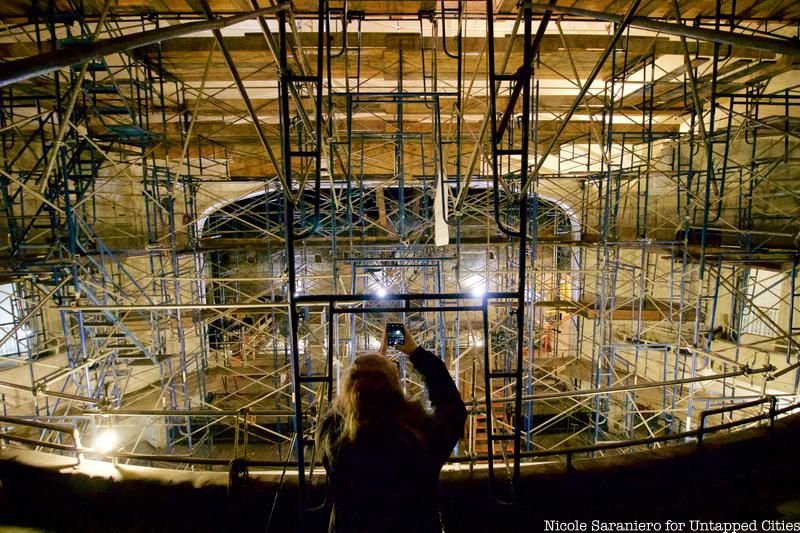
Opened on September 30, 1920 by Edgar and Arch Selwyn, the Times Square Theater has lived a long complicated life. Housing 1,057 seats and designed by Eugene DeRosa, the venue has housed several hit plays, including Gentlemen Prefer Blondes, Strike Up The Band, and Private Lives. It ceased operating as a theater until 1934, when it was converted into a movie theater with the stage converted into a retail store. With that renovation, the Times Square Theater ended its run as a theater.
In the 1980s, the movie theater closed and has since struggled to maintain a tenant. There have been multiple proposals and signings, but due to its expense, none of those companies — including MTV, Ecko Unlimited, Marvel Mania, and the Live Entertainment Corporation of Canada — have taken any concrete steps. In 2012, a chance at revitalization occurred when a long term lease was signed to make a film presentation called Broadway 4D, a dedication to the history of Broadway. It was expected to open last spring, but in 2014 it was reported the project was canceled because of financial problems. As of 2019, the theater was undergoing a $100 million redevelopment into a mixed-use commercial destination.
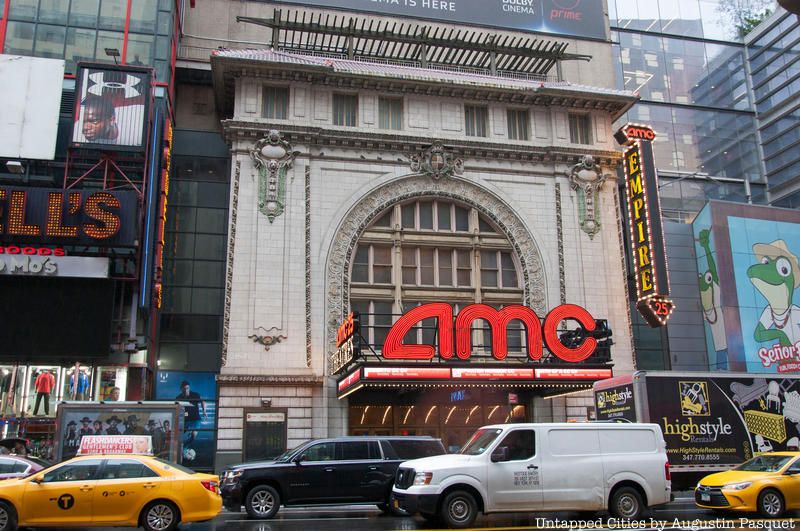
The Empire Theater opened in 1912 as the Eltinge 42nd Street Theatre. It was built6 by Al Woods and named for Julia Eltinge, a female impersonator who helped start Woods’ career. Designed by Thomas Lamb, the theater was unique for having a new seating system that included “slender,” “medium,” and “stout” options. Eventually Woods also lost the theater to the Great Depression, and it was converted into a burlesque house. In 1942, it became the Laff Movie theater, and in 1954 it was named the Empire Theater and showed only movies.
In 1997, the building was lifted from its foundation and moved 168 feet westward. The structure was changed into a retail spot and today stands as the entrance to an AMC theater. This theater was also removed from landmarks consideration, likely due to the extensive alterations. Check out historical remnants inside the AMC Empire 25 Theater in Times Square for more and buildings in New York City that have been moved.

The Liberty was a Broadway theater from 1904 t0 1933, built by the partnership of Klaw and Erlanger that brought us the New Amsterdam Theatre. It had a 100-foot long lobby and a beautiful Neo-Classical facade. It also had a rather patriotic theme with a carving of the Liberty Bell and a large stone bald eagle at the bottom of the facade.
Much like the rest, the Liberty was converted into a movie theatre instead of going dark, which began a long process of decline for the theater. By 1996, most of the original architecture had been removed, some of it hidden behind a boxy marquee, and the rest remodeled. The inside was no better, falling into dirty and decrepit disuse. Many of the beautiful older features, like the balconies, were closed off. In 1997, a few plans were made to convert the venue into a reality arcade, a plan that fell through plunging the theater into another decade of disuse only to be revived as a Dave & Busters in 2011 (it closed in 2013). Today, the theater runs as a bar and night club, with the auditorium space used for special events.

The Palace Theatre opened in 1913 as the world’s most famous vaudeville house until the 1930s, hosting many famous performers such as the Marx Brothers and Harry Houdini. If you had the chance to perform at this theater, you “made it.” When the Depression hit, like most theaters, it had to adapt to the times, so with the increasing popularity of films, the Palace became a movie theater from the 1930s to the early ’60s.
In 1966, the Nederlander Organization bought the Palace and converted it back into an operational Broadway theater. Since becoming a legitimate theater again, the venue ran many famous and award-winning shows. In the 1980s, two big hits were musicals La Cage aux Folles (the Palace’s longest running show at 1,761 performances!) and Woman of the Year, both of which garnered many Tony Awards.
Use code “Untapped” to save $10 off your first purchase for a Broadway show on TodayTix! Next, check out Vintage Photos: The Evolution of Times Square from 1989 to Today
Subscribe to our newsletter